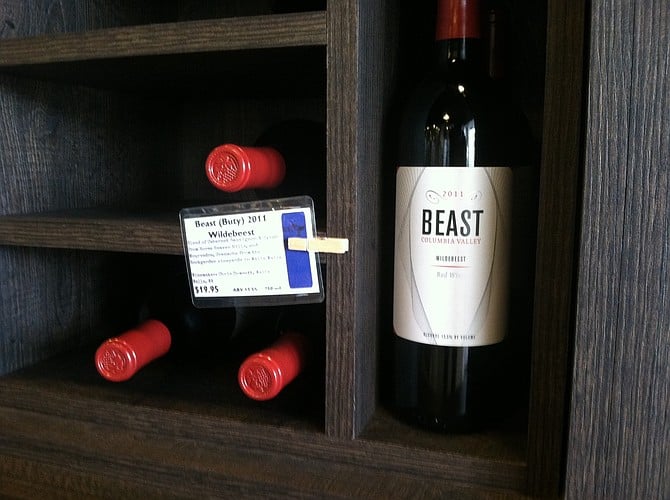 Facebook
Facebook
 X
X
 Instagram
Instagram
 TikTok
TikTok
 Youtube
Youtube

Near as I can tell, Buty Vineyards produces Beast wine as the experimental section of their operation in Washington’s Columbia Valley.
For this particular bottling, the winemakers blended Syrah, Cabernet Sauvignon, Grenache, and Mourvèdre (if the signage reads true) into a deeply tinted red. It’s $9/glass or $20/bottle at Pacific Time. It’s dark enough that a single glass obscures a hand, and the flavor is as beastly as intended.
First, it’s cherries, cherries, cherries, and whether the nose or palate picks up on it more is up for debate. But there’s something going on there below the cherry sweetness, and it takes a little delving into deeper memories to get there.
When I was a kid, fishing trips with Dad often involved long days spent hiking deep into the woods in search of trout streams where the deep shadows of old trees cast a perpetual twilight, and the fishing went on more or less on all day. We got hungry, slogging through the muck and branches, so we often wrapped up fishing days with tailgate picnics of deli sandwiches, chips, and sodas purchased from country stores, the waxed paper wrappers used for plates.
The thing that lurks beneath the cherries in every glass of Wildebeest is the distinct tang of botany, somewhat spicy but more bitter, almost like Gentian root and citrus rind. Cut with undercurrents of vanilla, the whole thing backs up the cherry overtones. Once I got it into my head, I couldn’t shake an association with Cherry Coke.
And there it was. Summer afternoons of sipping sodas and chewing sandwiches with dad, all bottled up in a four-and-a-half-year-old Washington wine. It’s coincidence that Pacific Time keeps an Italian sandwich on their menu ($9), but the salami, capicola, mortadella, vinaigrette, and spicy peppers would be just the thing to pair with a wine that makes you think of everything good about a cold soda, without the obesity-inducing sugar.
Given the choice between conveying sophistication or rusticity as their product’s perceived message, most winemakers would select the former. But never underestimate the appeal to childhood memories of the country, a trout stream, and a sandwich eaten off the lowered tailgate of a Chevy C10.


Near as I can tell, Buty Vineyards produces Beast wine as the experimental section of their operation in Washington’s Columbia Valley.
For this particular bottling, the winemakers blended Syrah, Cabernet Sauvignon, Grenache, and Mourvèdre (if the signage reads true) into a deeply tinted red. It’s $9/glass or $20/bottle at Pacific Time. It’s dark enough that a single glass obscures a hand, and the flavor is as beastly as intended.
First, it’s cherries, cherries, cherries, and whether the nose or palate picks up on it more is up for debate. But there’s something going on there below the cherry sweetness, and it takes a little delving into deeper memories to get there.
When I was a kid, fishing trips with Dad often involved long days spent hiking deep into the woods in search of trout streams where the deep shadows of old trees cast a perpetual twilight, and the fishing went on more or less on all day. We got hungry, slogging through the muck and branches, so we often wrapped up fishing days with tailgate picnics of deli sandwiches, chips, and sodas purchased from country stores, the waxed paper wrappers used for plates.
The thing that lurks beneath the cherries in every glass of Wildebeest is the distinct tang of botany, somewhat spicy but more bitter, almost like Gentian root and citrus rind. Cut with undercurrents of vanilla, the whole thing backs up the cherry overtones. Once I got it into my head, I couldn’t shake an association with Cherry Coke.
And there it was. Summer afternoons of sipping sodas and chewing sandwiches with dad, all bottled up in a four-and-a-half-year-old Washington wine. It’s coincidence that Pacific Time keeps an Italian sandwich on their menu ($9), but the salami, capicola, mortadella, vinaigrette, and spicy peppers would be just the thing to pair with a wine that makes you think of everything good about a cold soda, without the obesity-inducing sugar.
Given the choice between conveying sophistication or rusticity as their product’s perceived message, most winemakers would select the former. But never underestimate the appeal to childhood memories of the country, a trout stream, and a sandwich eaten off the lowered tailgate of a Chevy C10.
Comments